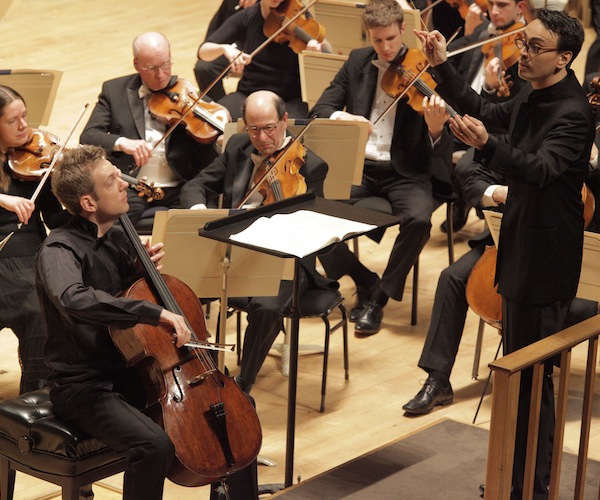Concert Review: Cellist Johannes Moser joins the BSO Out on the High Seas
Johannes Moser is a cellist I have admired for some years, based on his solid discography, innovative programming decisions, and championing of lesser-known and new compositions.

Conductor Ken-David Masur and cellist Johannes Moser performing with the Boston Symphony Orchestra. Photo: Hilary Scott.
By Cashman Kerr Prince
On Thursday night the Boston Symphony Orchestra welcomed the Canadian-German cellist Johannes Moser to the stage of Symphony Hall for a program of Romantic music full of drama and thrills (through January 24). Ken-David Masur, Assistant Conductor of the BSO, stepped in for an ailing Tugan Sokhiev and led this concert to safe harbor.
The evening opened with Berlioz, “Le Corsaire” Overture, op. 21 (original version 1844; revised 1852). The opening volley of notes prepared us for the dramatic, including swashbuckling adventures. Immediately came the lyrical Adagio, giving voice to the piece’s fascination with lawlessness on the high seas. That theme returned in a faster (Allegro) tempo that captured the varied moods on the ocean and humanity’s response to them. Like a well-run ship, the orchestra remained a tight ensemble: individual voices shone through the denser textures with clarity, thanks to the disciplined and thoughtful orchestration. The Corsair might have gone out of bounds from time to time (like the Byronic hero Berlioz admired), but this performance was always under Ken-David Masur’s tight control. He danced on the podium with a lithe grace that matched the flowing music, and then took on a more serious mien when the waters grew choppy. This “Corsair” was a friendly pirate with rough edges, yet always tuneful: an exciting opening to this concert.
Johannes Moser took the stage as soloist in Saint-Saëns, Cello Concerto no. 1 in a, op. 33 (1872). Moser is a cellist I have admired for some years, based on his solid discography, innovative programming decisions, and championing of lesser-known and new compositions. So I was eager to hear him live, and this Boston début did not in any way disappoint. This one-movement concerto is now a staple of the cellist’s repertoire (unlike the same composer’s second concerto, rarely heard—but recorded on an all-Saint-Saëns disc by Moser). It can come across as overly familiar, even banal, its sound homogeneous. Moser gave a stupendous performance of this music. Although I know the piece well, here I heard it fresh, lively, filled with excitement and executed with an enviable ease. Musically nuanced and evincing a great sensitivity to the manifold shades of texture and tone, this was as fine a performance as I have encountered. Only when his bow whipped through the air as he finished a phrase did Moser call attention to himself. The music came first, not any desire to deliver a flashy performance. The cellist was attentive to the orchestra, which responded in the same spirit to make this an invigorating experience.
Following intermission, the BSO returned to the stage with full forces for Rimsky-Korsakov’s Symphonic suite, “Scheherazade,” op. 35 (1888). Inspired by Tales of a Thousand and One Nights, this familiar piece is a crowd-pleaser which is a challenge to perform. It is loaded with instrumental solos—notably the solo violin giving voice to Scheherazade (here played by concertmaster Malcolm Lowe), but also cello (Martha Babcock), horn (James Sommerville), clarinet (William R. Hudgins), bassoon (Richard Svoboda), oboe (John Ferrillo), trumpet (Thomas Rolfs) and indeed the entire brass section, not to mention the full battery of percussion players and, last but not least, harp (Jessica Zhou). This impressionistic work changes its character rapidly; the score is rife with tempo modulations. The celli play pages of wave-like arpeggios and then are are called on to paint choppy seas and a shipwreck in the finale. They also have to evoke the rhythm of camels walking across desert sands, and add gravity to the Sultan at his most imposing. Other instruments face similar challenges.
Scheherazade can be a load of cheap thrills (even when not programmed with music from the film score to Aladdin). Masur worked to maintain cohesion across this lengthy work, marking contrasts in tempo and dynamic, changing musical colors, and seeing to it that Scheherazade survives to regale us with another nighttime tale. The orchestra as a whole seemed less responsive than usual, notably towards the end of the second movement where the indicated piano dynamic was not achieved and the ship seemed poised to wash out to sea. There were some ensemble issues in the frenetic finale. These slips reduced the whole to its individual voices. It also detracted from the fine solo work; all the musicians played to a high standard, but I was most captivated by Hudgins in the clarinet solo, thanks to his warm tone and passionate phrasing. I hope the ensemble issues are resolved so later audiences might have the chance to hear Masur’s take on Rimsky-Korsakov and appreciate Scheherazade in its entirety.
Cashman Kerr Prince holds degrees in Classics and in Comparative Literature from Wesleyan University, Stanford University, and l’Université de Paris 8 and is currently affiliated with the Department of Classical Studies at Wellesley College. Outside academic circles he is a cellist with the Brookline Symphony Orchestra and also serves on their board. You may have read his concert reviews and articles for The Boston Musical Intelligencer over the last number of years. He is happy to expand his horizons and review theatre, dance, music, and CDs for The Arts Fuse.
Tagged: Boston Symphony Orchestra, Cashman Kerr Prince, Johannes Moser
